Warhammer 40,000: Risk Review
Last Updated on March 9, 2022 by FauxHammer
The entire, grim universe of the 41st Millennium stretches out before you in the new Warhammer 40,000: Risk board game. Take on supreme command of either Space Marines, Aeldari, Genestealer Cults, Orks, or Chaos Space Marines as you vie for ultimate control in this game for 3-5 players.
Please Note: This site uses affiliate links. Our Affiliate Partners are shown below
(Affiliate links will result in compensation to the site on qualifying purchases)
Click this link & buy your hobby stuff from Element Games for the UK & Europe to support FauxHammer.com – Use Code “FAUX2768” at the checkout for double reward points.




Our Affiliates / Hobby Stores
- UK: Element Games, The Outpost, Wayland Games, Mighty Lancer, Goblin Gaming, Forbidden Planet, Model Scenery Supplies, eBay, Amazon
- US/Canada: MTechCave, GameKastle, eBay (US), eBay (CA), Amazon
- Germany: Taschengelddieb
- Europe: eBay (DE), eBay (FR), eBay (ES), eBay (IT), Amazon
- Australia: eBay, Amazon
- Global: RedGrass Games, Warcolours
- 3D Printers: Phrozen 3D, Elegoo, Anycubic
FauxHammer – Latest Video on YouTube
Warhammer 40,000: Risk Review – Summary
Whilst on the surface Warhammer 40,000: Risk may seem like little more than a reskin of the classic strategy board game, Risk’s rules translate extremely well into 40K’s grimdark setting – so much so, it seems hard to believe the two were ever separate entities in the first place.
Warhammer 40,000: Risk Review – Introduction
Risk, the board game of global strategy, diplomacy and conquest, has arrived in the Warhammer 40,000 universe.
Well, it actually arrived back in 2020, but GW decided to remind us all that it existed last week (22/02/2022) by announcing it was moving it onto special order at the bottom of a Warhammer Community article all about brand-new Aeldari and MacFarlane Action figures – so no need to feel bad if you missed it.
Over the 65 years that have passed since its original release in 1957, Risk has grown to be one of the most popular board games of all time. The internationally-renowned strategy game, which sees players take control of a superpower and try to claim the board for themselves, has taken many guises over the course of its illustrious career.
From its original setting in the real world and its medieval Europe variant, to franchises such as Lord of the Rings, Star Wars, Halo, Call of Duty: Black Ops Zombies, Narnia, the Napoleonic Era, Mass Effect, StarCraft, The Walking Dead and even Plants vs. Zombies, Risk has touched just about every fandom and popular culture phenomenon out there at some point over the course of its lifetime. In fact, there have been so many different variations of the game that it’s many variations have become collector’s items.
Today, we have a look at how the classic game adapts to the grimdark universe of Warhammer 40,000 to see if once and for all one of the setting’s myriad factions can claim total supremacy in a galaxy ripped apart by war.
Warhammer 40,000: Risk Review – Unboxing
Warhammer 40,000’s take on Risk – or Risk’s take on Warhammer 40,000, whichever you feel is more appropriate – comes packaged in a box printed with some delightful artwork depicting Abaddon the Despoiler and his Black Legion kicking the ever-loving snot out of a bunch of Ultramarines and some of their Imperium allies (can you see the AdMech chappie having his robo-brains blown out?).
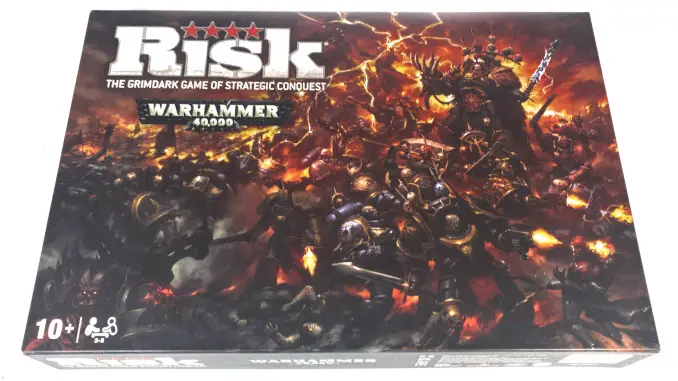
As someone who’s been painting a lot of Black Legion stuff recently, I wholeheartedly approve this message.
Inside the box, we have a sheet of five push-out tokens, the Instruction Manual, and the folded board.
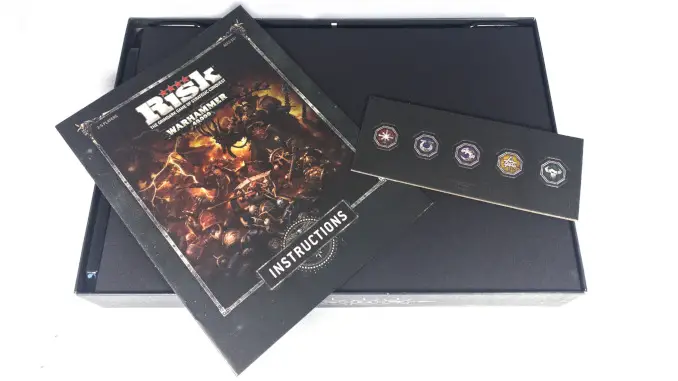
Beneath the board, we have everything else – cards, playing pieces, and dice.
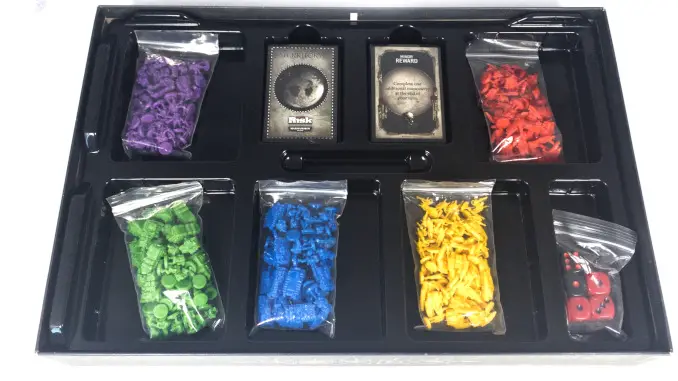
We’ll have a closer look at everything in the box in a moment.
Warhammer 40,000: Risk Review – Contents
Warhammer 40,000: Risk comes with the following components:
- 1 x Gaming board
- 1 x Rule book
- 5 x Leader tokens
- 200+ x Unit Miniatures
- Space Marines are represented by Primaris Intercessors and Primaris Repulsors
- Chaos Space Marines are represented by Chaos Space Marines and Heldrakes
- Aeldari are represented by Guardians and Falcons
- Orks are represented by Ork Boyz and Battlewagons
- Genestealer Cults are represented by Acloytes and Goliaths
- 83 x Cards, as below:
- 5 x Leader Cards
- 42 x Territory Cards
- 20 x Objective Cards
- 16 x Reward Cards
- 5 x Dice, as below:
- 3 x Attacker Dice
- 2 x Defender Dice
Cards
The Warhammer 40,000: Risk game comes with four types of cards: Leader Cards, Territory Cards, Objective Cards and Reward Cards. In the image below, the Territory Cards are the large stack in the top left corner, the Reward Cards are in the top right (split into Major and Minor piles). Immediately below them are the Objective Cards (also split into Major and Minor). Along the bottom of the image are the five Leader Cards.
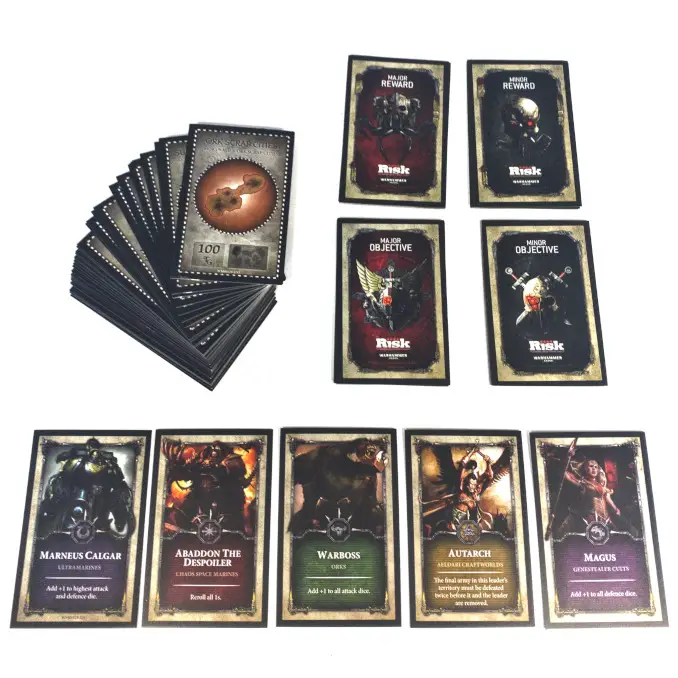
Aside from the Leader Cards, which have images of each faction’s commander, the rest of the cards are fairly spartan in their appearance.
Eagle-eyed readers will notice that of the five factions you can choose to play as in Warhammer 40,000:Risk, only two of them have named leaders. The Space Marines are led by Marneus Calgar and the forces of Chaos are led by Abaddon the Despoiler. The Orks are simply led by a “Warboss”, the Aeldari an “Autarch”, and the Genestealers by an also unnamed “Magus”, which is a little bit of a shame. You could’ve at the very least let the Orks be led by Ghazghkull Mag Uruk Thraka – but then again, I suppose that’s a difficult one to fit on a small card.
None of the cards are particularly large, so what surface area there is on them is dedicated to information over iconography. This isn’t a bad thing, as the cards are very clear and easy to understand, with objectives, rewards, and rules explained in only a few words. You won’t have to stop the game for fifteen minutes every time you draw a card in order to make sure you understand everything that’s written down on each one you take.
Tokens, Counters and Other Markers
As we’ve just had a quick look at Leader Cards, now feels like a good time to show off the Leader Tokens.

Unfortunately, each of the leader don’t have their own unique figures in the box – though, can you imagine trying to find a tiny Calgar in amidst a pile of tiny blue Space Marines, or a miniature red plastic Abbadon in a bag full of pieces the exact same colour? Instead, each is represented by a push-out cardboard token.
On the theme of stuff printed on card, we also have the game’s board. Depicting the Nachmund Gauntlet – the hotly-contested corner of space over which everyone seems to be fighting at the moment (and those who aren’t look set to be doing so soon) – the game’s is pristinely on-trend with what is going on elsewhere in the wider Warhammer 40,000 narrative.
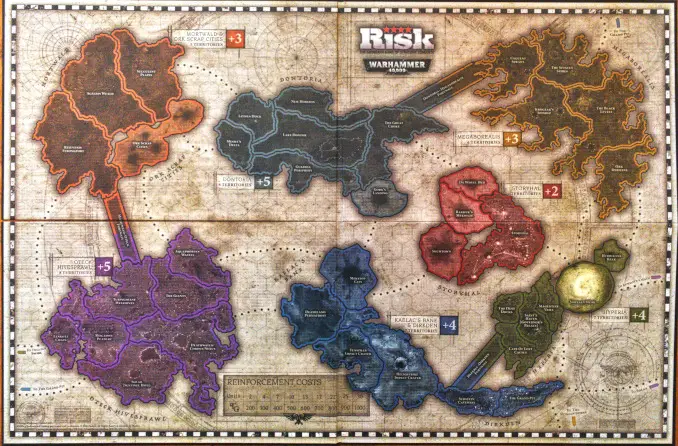
Territories are clearly divided and labelled, so navigating your great campaign through the Nachmund Gauntlet shouldn’t be too difficult to do from the comfort of your home.
Oh, and there are, of course, dice.
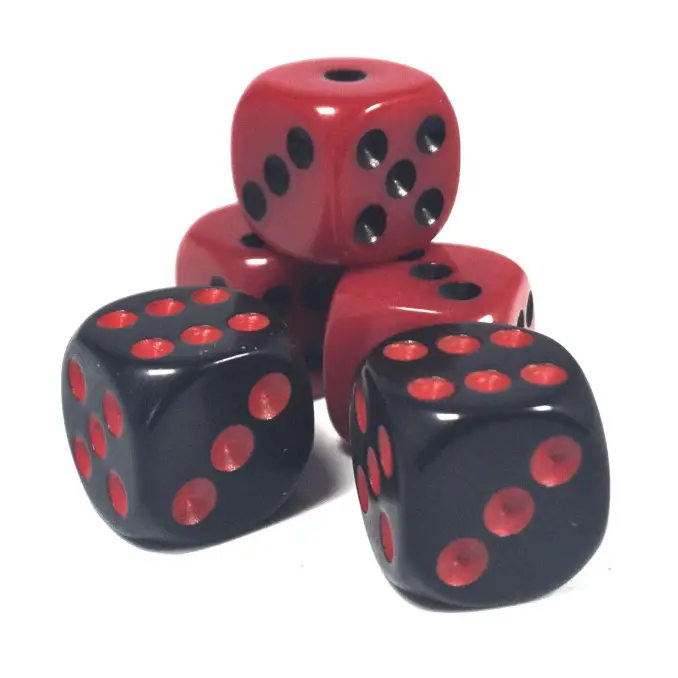
Aside from being a relatively standard fare in terms of their size and weight, the dice in the Warhammer 40,000: Risk board game are at least thematically coloured.
There are two types of dice in risk: Defender Dice, which are in black, and Attacker Dice, which are in red. We’ll see these dice again later on when we have a go playtesting this game.
Miniatures
GW report that there are over 200 miniatures in the Warhammer 40,000: Risk game. I’m going to elect to believe them on this one, as I really don’t want to spend my Sunday afternoon counting these teeny-tiny little plastic markers when I could be playing Elden Ring prepping future content.

There are two types of marker for each faction: a soldier and a vehicle. The soldier counts as a Single Unit in the game, whilst the vehicle counts as a Triple Unit. In other versions of Risk, there have often been three unit types: Infantry, Cavalry and Artillery, work 1, 2 or 3 Uniuts respectively. 40K’s version, however, just has the two, worth 1 and 3.

Each little figurine representing a Single or Triple Unit is faithfully based on something from its corresponding Warhammer 40,000 faction range, and are rendered in a colour of plastic that is in some way related to one of their faction colour schemes.
The Orks are represented by Boyz and Battlewagons, whilst the Aeldari field Guardians and Falcons.
Space Marines are represented by Primaris Intercessors and Primaris Repulsors
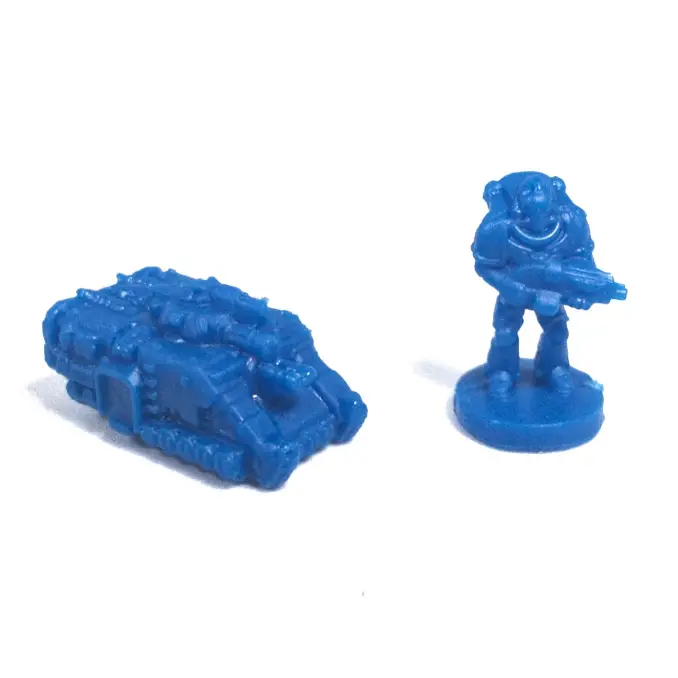
Chaos Space Marines are represeted by, well, Chaos Space Marines and Heldrakes, whilst the Genestealer Cults are represented by Acolytes and Goliaths.
For a sense of scale, here’s the a Space Marine figure from the Risk box next to an easy-to-build Assault Intercessor from Issue 3 of Hachette’s Warhammer 40,000: Imperium magazine which I painted a few months ago.
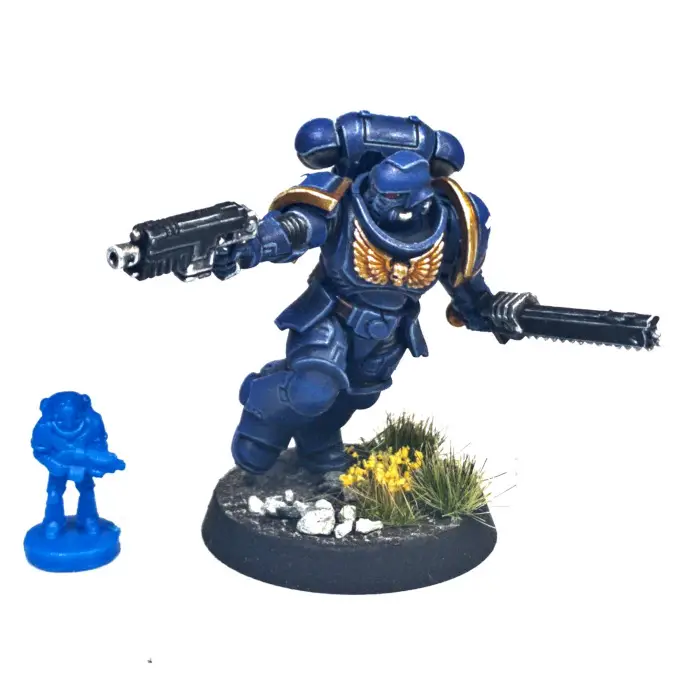
These little figures are really tiny and aren’t all that detailed, so you’re unlikely to want to invest any of your time or paint into painting them up – unless you’re after a real challenge.
Warhammer 40,000: Risk Review – Playtesting
Warhammer 40,000: Risk’s Instruction Manual comes with all the instructions you need to play the game via two different Play Modes:
- Mode 1 is the Basic Game, and is won when a player completes 3 objectives
- Mode 2 is the Total Domination Game, which shares the same rules as the Basic Gam, but in order to win a player must complete their three objectives and then wipe out all of their opponents.
Set Up
Setting Up Warhammer 40,000: Risk isn’t too difficult. There are a few steps to follow, but the Instruction Manual walks you through them.
First off, players have to ensure that the main gaming board is placed on a flat surface with space around it – a table, a floor, whatever’s easiest for you.
Next, players need to shuffle the Territory Cards and leave them in a pile near the board. Territory cards are then allocated to players as follows/as applicable:
- Player 1 – 0 cards
- Player 2 – 0 cards
- Player 3 – 1 card
- Player 4 – 1 card
- Player 5 – 2 cards
Players must then separate the Minor and Major Objective Cards and shuffle them into two piles. Someone then draws 4 of each card and places them face-up next to the gaming board where all players can see them. The remaining Objective Cards are then put away back in the box.
With that done, players must then shuffle the Minor and Major Reward Cards and leave them face-up in two piles next to the gaming board. When players complete objectives, they will be able to claim a reward Card of their choice from the top of the pile.
Next, players choose their faction. The Instruction Manual suggests players roll-off in order to do this, the person who rolled the highest choosing first and so on until everyone has a faction.
Finally, now each player has a faction, players are allocated their armies for deployment. Army size varies depending on how many people are playing (5 players – 20 armies each; 4 players – 25 armies each; 3 players – 30 armies each). Starting with the first player, players take it in turns to place a single army into a territory of their choosing until all the territories have been claimed.
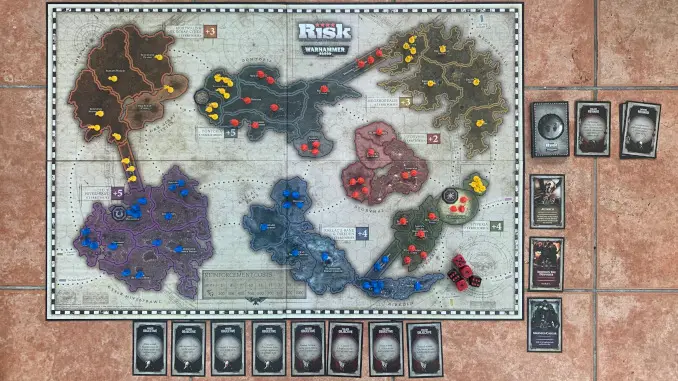
Once all the territories have been claimed, players continue to place their armies in territories they control until all their starting armies have been placed.
With that, the game can begin.
Playing the Game
Over the course of their turn, players can carry out the 4 following steps in the order they appear below:
- Recruit additional units to their armies
- Attack enemy territories with your own armies
- Complete objectives and claim rewards (if applicable)
- Manoeuvre armies and draw a Territory Card (if eligible)
1. Building Your Armies
Recruiting armies is simple enough. You take the number of Territories you control, divide it by three, and remove any decimal place. This is the base value of how many additional armies you can recruit. You can increase this number by:
- Adding to it any any bonuses you have to that number from regions – if, for example, you control all of the territories in a Megaborealis, you can recruit 4 additional armies.
- Purchase units using Throne Gelt. This is a currency shown on Territory Cards.
- Adding units gained via Reward Cards for completing objectives.
For example, at the start of their turn, the Ultramarines controlled 14 territories. 14 divided by 3 gives us 4.6, so we discard the .6 to get 4.
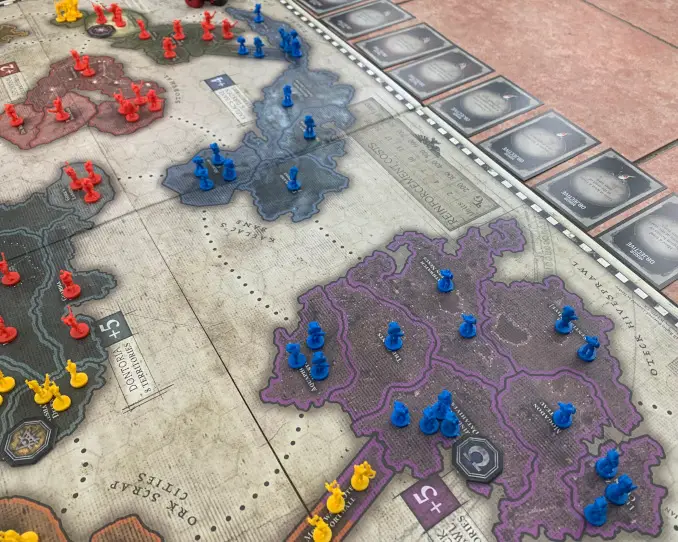
However, the Ultramarines also controlled all of Oteck’s Hivesprawl and Kaelac’s Bane and Dirkden, which give a +5 and +4 to recruitment respectively. So, 4+5+4 = 13, so the Ultramarines get another 13 armies.
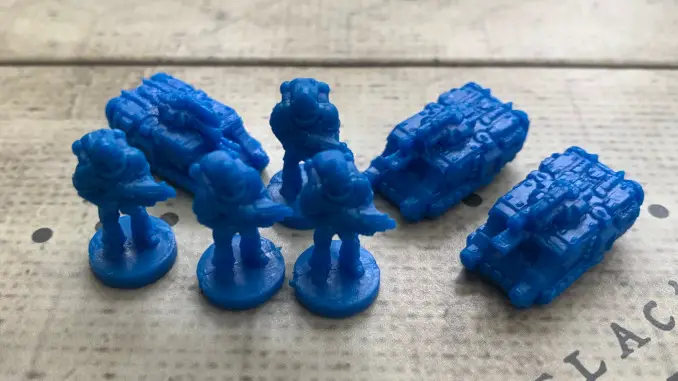
Once you’ve got all your new armies together, you can deploy them into territories of your choosing. With your armies reinforced, it’s time to…
2a. Attack Enemy Territories
Risk is a game of conquest, and as such in order to stand even the slightest chance of winning the game, you’ll have to invade your enemies’ territories and seize control of them. You don’t have to attack in your turn – but you won’t be able to conquer the galaxy with enemies at your borders.
In order to attack an enemy territory, players must…
- Choose a territory of their own that contains 2 or more armies (the minimum number has to be 2, as at least 1 army must stay behind to guard the territory the other army moves out of).
- Choose how many of their armies will attack an enemy territory. Players can attack with 1, 2 or 3 armies – but no more, irrespective of how many armies are in the defending territory.
- The defending player then chooses how many armies they will defend with – either 1 or 2. Again, irrespective of how many armies there are in a territory, the defending player can only defend with a maximum of 2 or their armies.
- Players then roll their attack/defence dice – one for each of their armies. So, if a player is attacking with 2 armies, they roll 2 dice. If the defender is defending with 1 army, they only roll 1 dice.
- Players then compare their rolls. Whoever has rolled the highest wins. If the highest rolls are ties, (i.e. both the defender and the attacker have rolled a 6), then the Defender wins.
- The loser then removes 1 army from their territory. If applicable, compare your second-highest dice rolls and remove armies as appropriate.
Once dice rolls have been resolved, the player can continue to attack if they so wish and are able to. The player can attack the same territories again or new ones.
In our example, the Aeldari in the Unguent Sprawl decide they’d rather like to kick the Chaos Space Marines currently hanging out in the Dontoria-Megaborialis Fortwall off their doorstep.
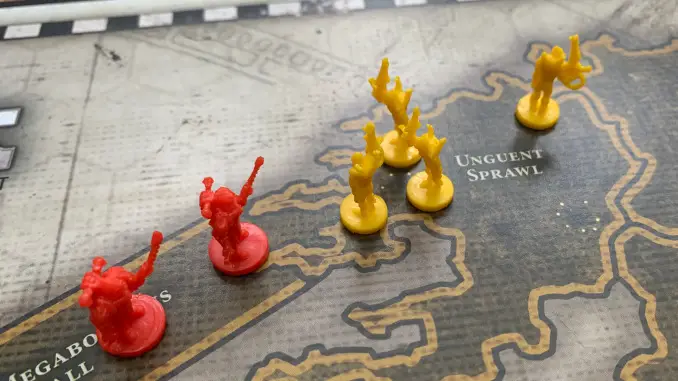
To do this, the Aeldari player attacks the two defending Chaos Space Marine armies with three of the four armies they had in the Unguent Sprawl. The Aeldari, attacking with three armies (as one has to stay behind to hold the territory), roll 3 Attack dice. The Chaos Space Marine player rolls 2 dice to defend.
Unfortunately for the Chaos Space Marines, the Aeldari thoroughly outrolled them and both their armies were destroyed, allowing the three attacking armies to claim the Fortwall territory. Glory to Khaine!
Should a Defender lose all their armies in a territory, the Attacker must move all their attacking armies into the conquered territory. Players can also move any armies from the adjacent attacking territory too. So, whilst a player may have 5 armies in an attacking territory, and can only attack a defending territory with 3 armies, should they conquer the defending territory, they can then move 4 armies into that territory, leaving one army behind to defend. There must always be at least one army in a territory – territories cannot be abandoned, so there should always be a coloured figure in every section of the map.
2b. Defeating Enemies
A player is defeated when they have lost all of their territories. Should all of their coloured pieces be removed from the board, they are removed from the game.
Should a player defeat another player by removing all their armies from the board, the conquering player – i.e. the player who removes their last army – receives all that player’s Territory Cards and completed Objective Cards. The defeated player’s Reward Cards are discarded, so no-one gets them.
3. Completing Objectives and Claiming Rewards
The objectives that can be completed during a game of Warhammer 40,000: Risk are determined by the selection of Major and Minor Objective Cards that are drawn during the set up period of the game.
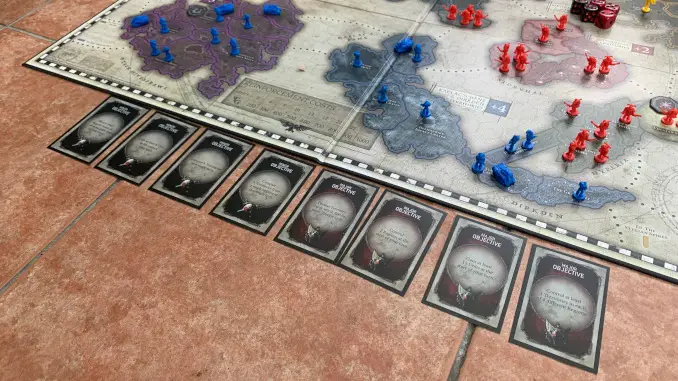
Once a player has finished attacking their enemies, they should take note of the Objective Cards available and see if they have completed any of them during the duration of their turn. If a player has completed an objective, they should take the corresponding card and hold on to it. The card is not replaced: the victor must obtain 3 objective cards to win, and objectives are a finite resource (you can, of course, take them by conquering your opponents).
To further complicate matters, players can only obtain 1 Objective Card per turn. If, for example, a player was to gain control of 3 Territories in each of 4 different regions, and then eliminate 2 Leaders in the same turn, they could only choose to claim the corresponding objective card for one of those completed objectives.
Should a player complete an objective, they can then draw a Reward Card. As with Objectives, which come in two flavours – Major and Minor – so do rewards. If a player completes a Major Objective, they take a Major Reward Card. If a player completes a Minor Objective, they take a Minor Reward Card.
4. Manoeuvring Armies
The final thing a player can do in the course of their turn is move their armies around. In order to do this, players can take as many armies as they would like from one of their controlled territories and move them to another connected territory. As always, players must ensure there is at least one army left in the territory they are moving their armies from, as they cannot abandon a territory.
In order for armies to be moved into another territory, the target territory must be connected to the territory from which the army is being moved. This means that there must be a clear route of adjacent territories that player’s control. You can’t move your armies through enemy-controlled territories.
After getting trounced by the Aeldari in the Dontoria-Megaborialis Fortwall, the Chaos Space Marines holding Dontoria were suddenly not so confident of their position. In order to try and strengthen their western territories against the two huge Aeldari armies (one of which was being led by the Autarch), the Chaos Space Marine player took the decision to move a number of their armies out of Gork’s Landing in the south-east to toughen up their west flank.
Once you’ve moved all your armies and your turn is at its end, if you conquered at least 1 enemy territory in the course of your turn, you must draw 1 Territory Card from the deck and add it to your hand. This comes with a few ifs:
- You can only collect 1 Territory Card, even if you conquered multiple territories in your turn
- The Territory Card does not have to correspond to a conquered territory
- If you’ve already collected an Objective Card on your turn, you can’t also collect a Territory Card
And that’s that! With as many of these 4 steps completed as one can legally complete, the turn passes to the next player.
5. Winning the Game
How one wins a game of Warhammer 40,000: Risk depends on which Play Mode players are engaged in. As mentioned earlier in this article, there are two possible ways to play Warhammer 40,000: Risk: Basic and Total Domination.
If players are playing the Basic Play Mode, all they have to do to win the game is obtain 3 Objective Cards over the course of the game. Whoever is the first to get 3 Objective Cards wins, irrespective of their Territory Cards or how their armies are looking on the game board.
The alternate mode, Total Domination, adds an extra step to winning the game. Players must still collect 3 Objective Cards, but they must then proceed to wipe out everybody else on the board. When they control every single territory on the board and hold a minimum of 3 Objective Cards, then they win.
Warhammer 40,000: Risk Review – Price and Availability
Grabbing yourself a copy of Warhammer 40,000: Risk Board Game shouldn’t be too difficult. Whilst it looks to no longer be available on Games Workshop’s webstore, you can currently grab yourself a copy from Amazon for around £45.
This may seem like a lot, but glancing over some of the other editions of Risk available, £45 is a pretty middle-of-the-road price: some of the Star Wars editions are over £60, whilst the basic, “original” clocks in at around £25.
Warhammer 40,000: Risk Review – Final Thoughts
| Pros | Cons |
| Interesting and faithful spin on a classic game Will really appeal to Warhammer 40,000 collectors Genuine good fun | Can sometimes feel a little bit like a reskin of an already existing game |
In the name of balance, I had to dig pretty deep in order to think of a con to go in the list above.
It is, at its core, just classic Risk wearing some Warhammer 40,000 merch – but that’s about the only thing I can knock it for. And that’s not necessarily even a bad thing, especially if you’re into sci-fi over Risk’s classic historical setting.
There really isn’t much to dislike in the Warhammer 40:000 Risk board game. The components in the box are good quality (the tiny little miniatures are surprisingly detailed for what they are), the price seems fairly reasonable, and the game is actually good, honest and straightforward fun.
Sure, it’s perhaps not the most inspiring release to ever leave the gilded doors of Games Workshop’s hallowed sanctum, but it is good fun – and that counts for a lot.
Please Note: This site uses affiliate links. Our Affiliate Partners are shown below
(Affiliate links will result in compensation to the site on qualifying purchases)
Click this link & buy your hobby stuff from Element Games for the UK & Europe to support FauxHammer.com – Use Code “FAUX2768” at the checkout for double reward points.




Our Affiliates / Hobby Stores
- UK: Element Games, The Outpost, Wayland Games, Mighty Lancer, Goblin Gaming, Forbidden Planet, Model Scenery Supplies, eBay, Amazon
- US/Canada: MTechCave, GameKastle, eBay (US), eBay (CA), Amazon
- Germany: Taschengelddieb
- Europe: eBay (DE), eBay (FR), eBay (ES), eBay (IT), Amazon
- Australia: eBay, Amazon
- Global: RedGrass Games, Warcolours
- 3D Printers: Phrozen 3D, Elegoo, Anycubic
FauxHammer – Latest Video on YouTube
What did you think of this Review? please let us know in the comments.
If you like what we’re doing here you could really help encourage more content with a share on any social media platform.
Click the share links at the bottom of this screen (or on the left for computers and tablets)
Want to keep updated with the site? You can subscribe in the sidebar for RSS or by email below
(Sidebar is below the article on Mobile Devices)






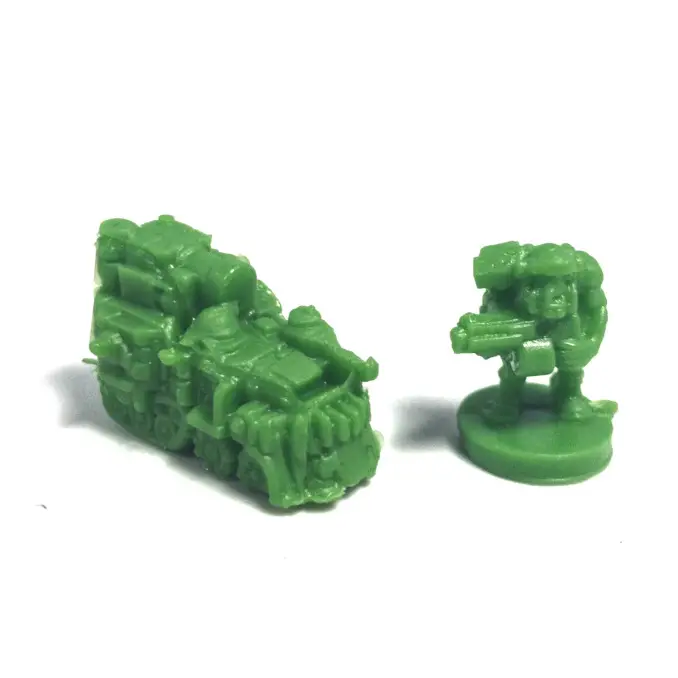
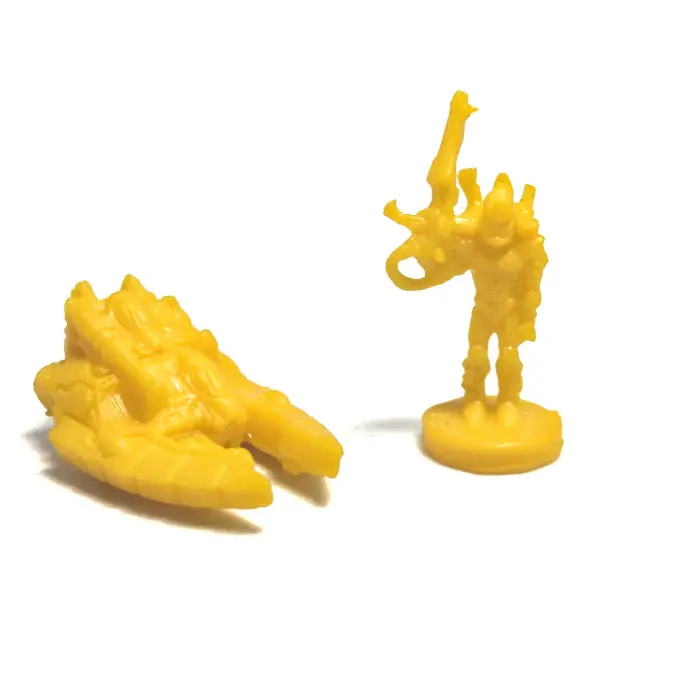
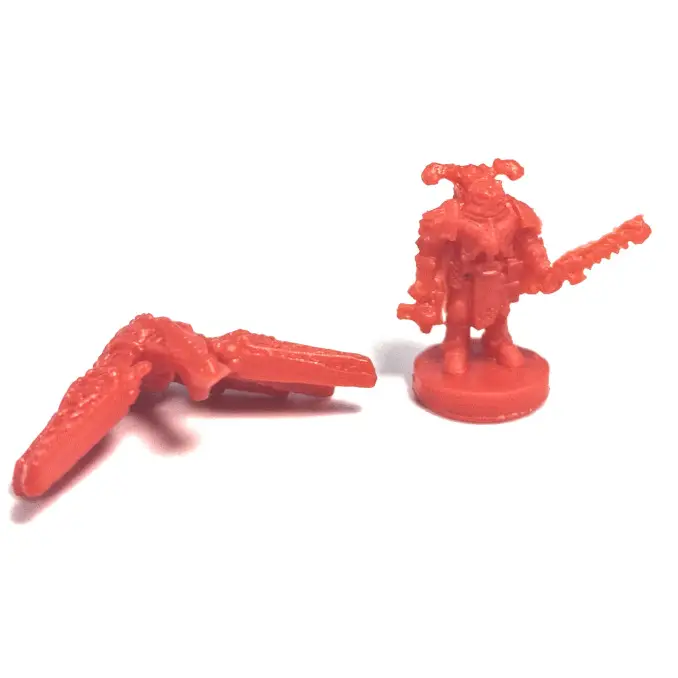
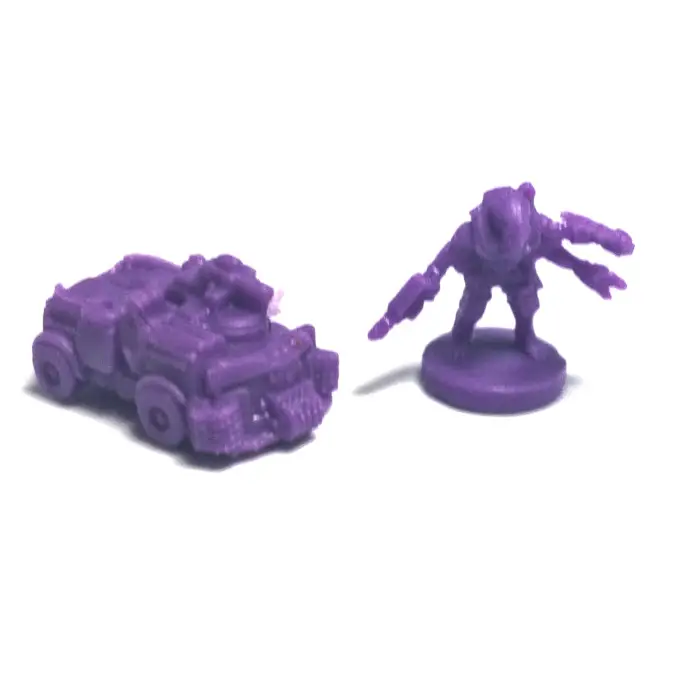
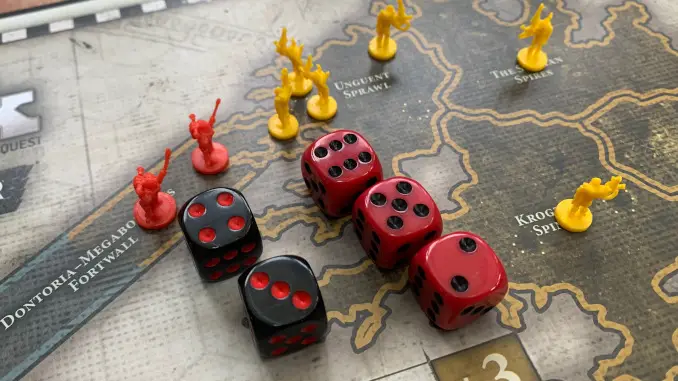
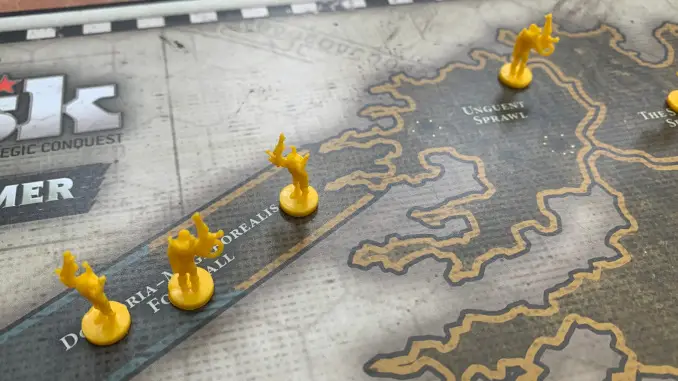
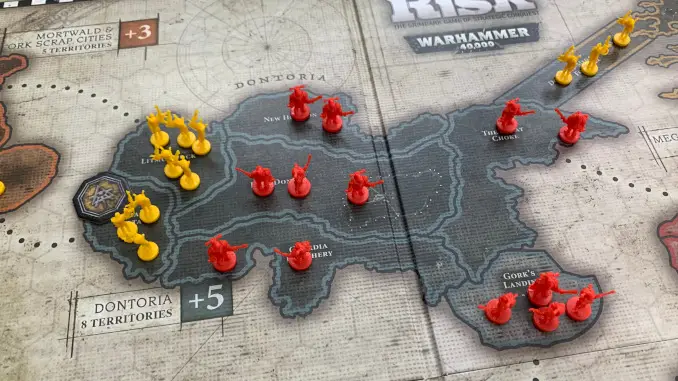
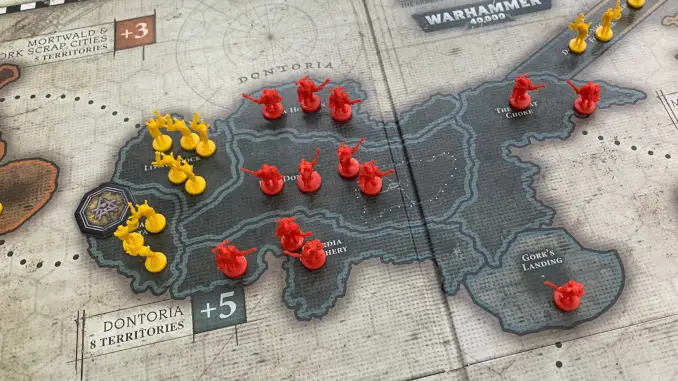
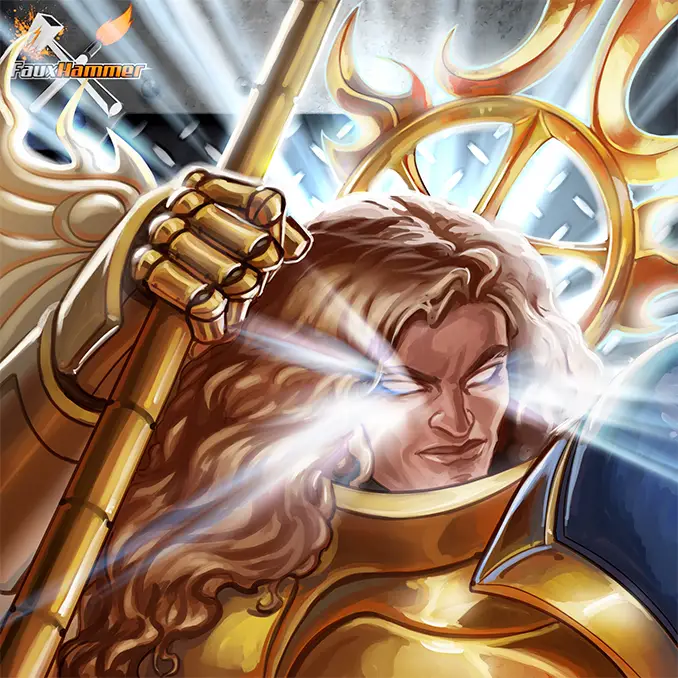
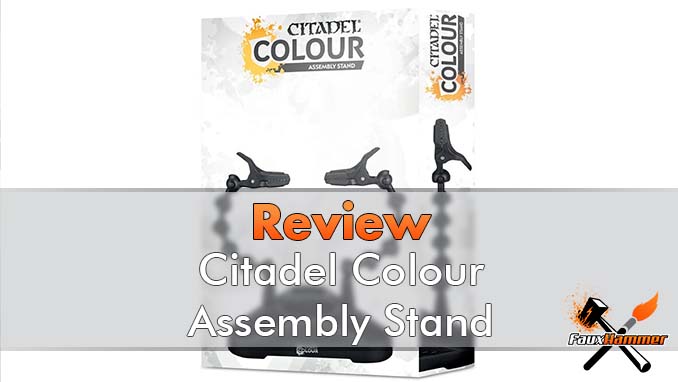
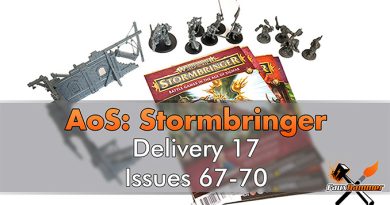
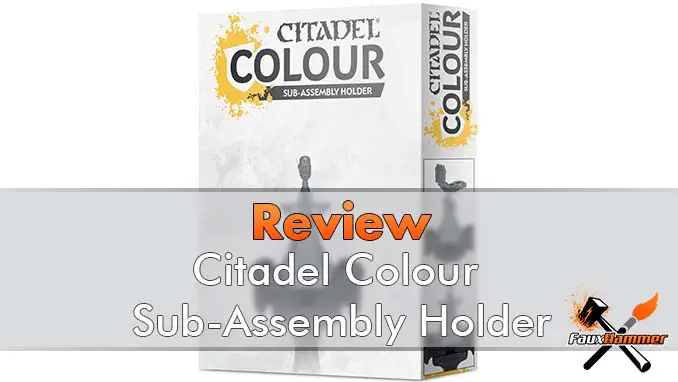
This is fun to play, the map is better than the standard one. The one element with the game I wasn’t so keen on (and isn’t really addressed much in this review either) is why are there Minor and Major objectives, if you can with with any three?! OK the rewards are better for Major objectives, but surely they should also count more towards victory! We enjoyed the leaders special abilities as well, but found the rules a bit confusing for them though we did eventually work it out. I enjoyed playing it, but it did help that I got it on sale from Zavvi at £19.99 last year!
Great review! I love how you highlighted the unique blend of strategy and Warhammer lore in Risk. It’s a fresh take on the classic game, and your insights really captured what makes it fun for fans of the franchise. Can’t wait to try it myself!